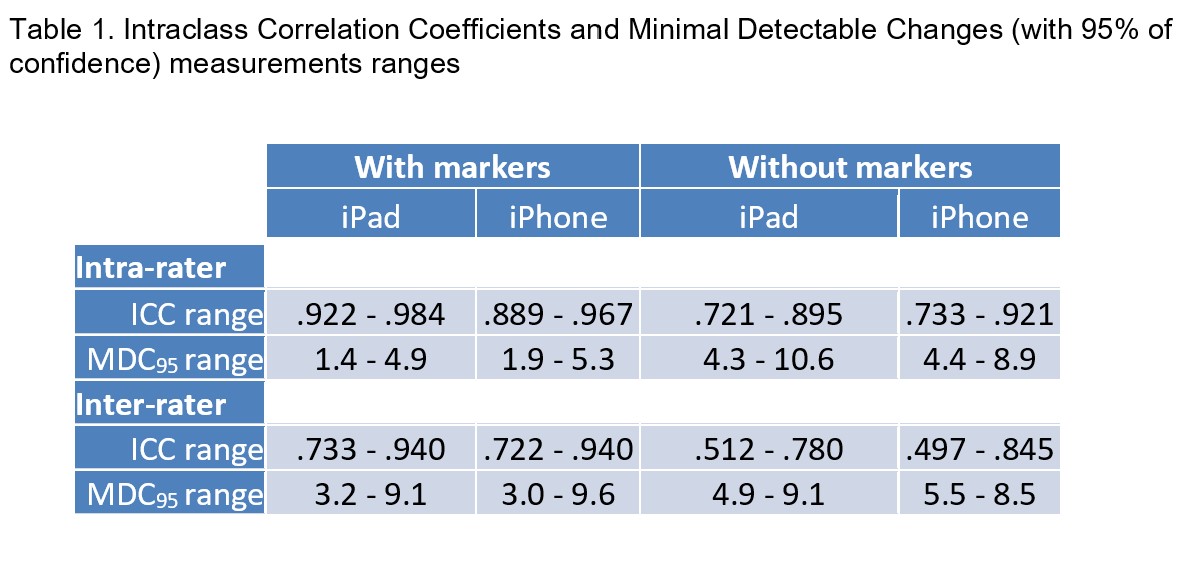Arrighi Lorenzo [Private practice, Milano, Italy]
Pellicciari Leonardo [IRCCS Istituto delle Scienze Neurologiche di Bologna, Italy]
Morandini Matteo [Degree in Physical Therapy, University of Florence, Florence, Italy]
Vannucchi Luca [Unit of Functional Rehabilitation, Department of Allied Health Professions, Azienda USL Toscana Centro, Florence, Italy]
Bravini Elisabetta [Rehability Bellinzona, Bellinzona, Switzerland]
La Porta Fabio [Private practice, Milano, Italy]
Vercelli Stefano [Rehabilitation Research Laboratory 2rLab, DEASS, University of Applied Sciences and Arts of Southern Switzerland, Manno, Switzerland]
Valid and reliable measurement tools are essential for assessing human movement and supporting clinical decisions in physiotherapy. Mobile devices can now be considered mainstream tools for collecting physical activity data and enabling motion analysis. The DrGoniometer app (DrG; CDM srl, Milan, Italy) has been developed to provide a simple and fast measurement of joint motion. It is a virtual goniometer placed over an image previously captured by the device’s camera. It is reliable and valid in the photographic goniometry measurement of the elbow, knee, shoulder, and first metacarpo-phalangeal joint [1,2,3,4]. Recently, the application has been updated by including the ability to measure a frame acquired from a video, and its reproducibility was studied during the assessment of the break-point angle in the Nordic Hamstring exercise. However, the reliability of the goniometric measurement during gait has not yet been verified. Aim of this study was to calculate the inter- and intra-rater reliability of the app in measuring knee and ankle joint angles during gait, and the agreement between the app and a reference method, i.e., motion analysis.
Thirty healthy adult subjects (mean±SD age: 29.3 years; 56.7% male) were simultaneously filmed with iPad and iPhone during normal gait. To avoid angle distortion, a trolley with a laser pointer was built with specific support for iPad/iPhone to keep them in a vertical position, guided in its path parallel to the subject’s gait by a taut stainless steel wire. Two conditions were recorded: a gait cycle with (greater trochanter, femoral condyle, lateral malleolus, and fifth metatarsal) and without markers with a simultaneous recording of an optoelectronic motion analysis system (SMART-E 600; BTS, Milan, Italy). The right knee and ankle joint angles at the toe-off and heel strike and the maximum knee flexion within the gait cycle were collected by three independent assessors (two physiotherapy students and one experienced physiotherapist). The intra- and inter-rater reliability were studied using the Intraclass Correlation Coefficient (ICC) and minimal detectable change (MDC95); the agreement between the assessment with iPad/iPhone and the gait analysis were analysed using the Bland-Altman plots.
The intra-rater reliability was excellent with markers and moderate-to-excellent without markers. The inter-rater reliability with markers was moderate-to-excellent, moderate-to-good for iPad and poor-to-good for iPhone. ICCs and MDC95 are reported in Table 1. The Bland-Altman plots showed a substantial agreement of the measurements with the DrG using iPad and iPhone and the optoelectronic system (all upper and lower limits of agreement ranges were between +-10 to 15°).
Joint angle measurements with DrG during gait are reliable in healthy subjects. Reliability was higher in assessments with markers, and using the iPad compared to the iPhone. The DrG app can be used in clinics to capture reliable joint angles during gait when a motion analysis system is not available.
1) Ferriero G, Vercelli S, Sartorio F, Muñoz Lasa S, Ilieva E, Brigatti E, Ruella C, Foti C.
Reliability of a smartphone-based goniometer for knee joint goniometry. Int J Rehabil
Res. 2013 Jun;36(2):146-51. 10.1097/MRR.0b013e32835b8269. PMID: 23196790.
2) Ferriero G, Sartorio F, Foti C, Primavera D, Brigatti E, Vercelli S. Reliability of a new
application for smartphones (DrGoniometer) for elbow angle measurement. PM R.
2011 Dec;3(12):1153-4. doi: 10.1016/j.pmrj.2011.05.014. PMID: 22192326.
3) Mitchell, Katy; Gutierrez, Simran Bakshi; Sutton, Stacy; Morton, Stephanie;
Morgenthaler, Andrea (2014). Reliability and validity of goniometric iPhone
applications for the assessment of active shoulder external rotation. Physiotherapy
Theory and Practice, 30(7), 521–525. 40
4) Otter, S.J., Agalliu, B., Baer, N. et al. The reliability of a smartphone goniometer
application compared with a traditional goniometer for measuring first
metatarsophalangeal joint dorsiflexion. J Foot Ankle Res 8, 30 (2015)

